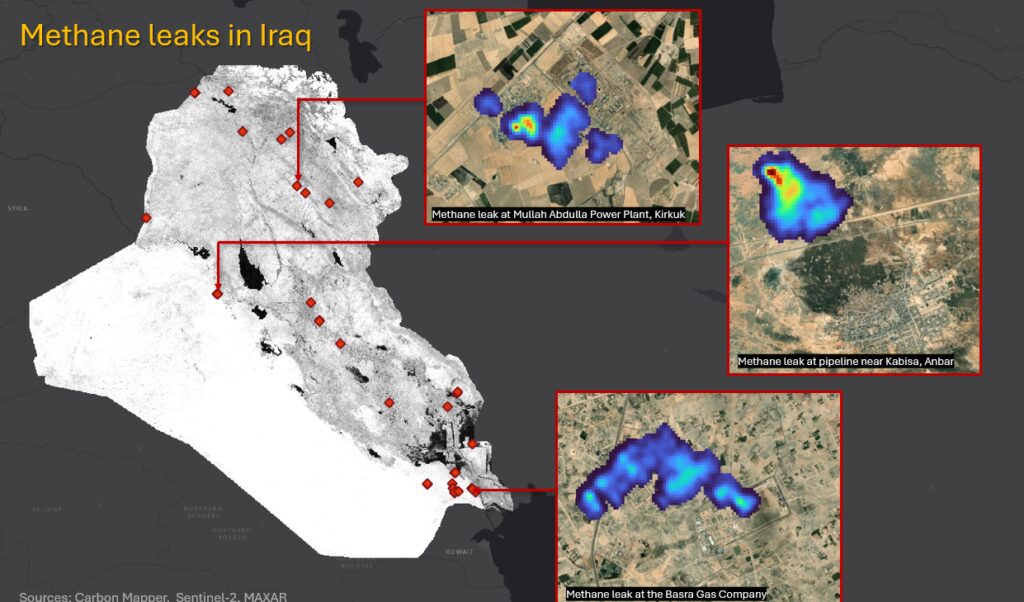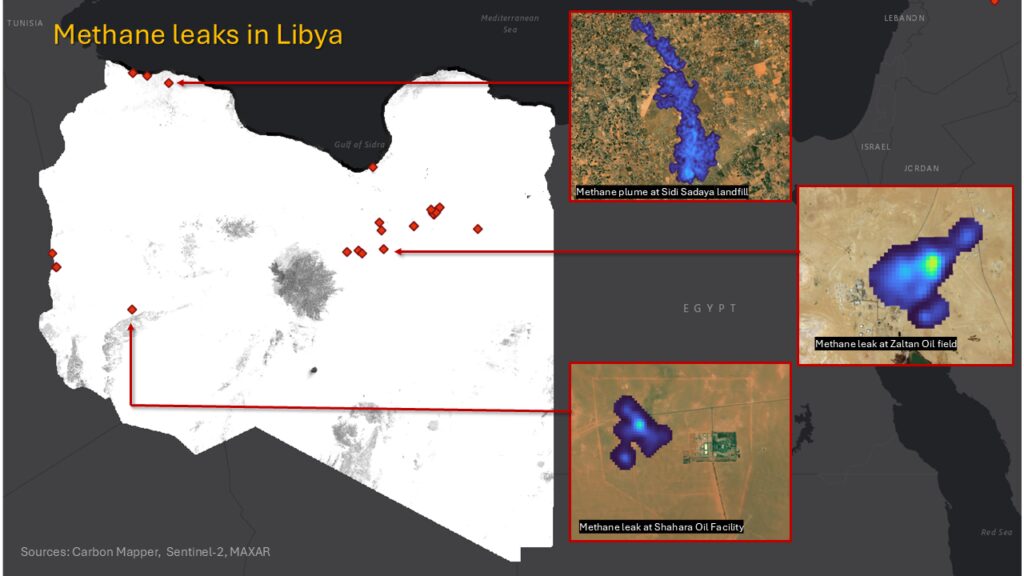How can reporters learn from new tools about specific causes of methane leaks in conflict-affected areas? We have examined some of the recent conflict hotspots across the Middle East and North Africa (MENA) — namely Syria, Iraq, Yemen, and Libya — to identify what the major sources of methane release are in the region, as well as to better understand how conflicts around the world could damage existing infrastructure and governance and lead to more emissions.
Methane (CH₄) is the second-largest contributor to the rapid heating of our planet and its contribution to global warming is estimated to be nearly 34-80 times higher than carbon dioxide (CO₂). Methane in the atmosphere also leads to more ozone in the troposphere, while methane oxidation in the stratosphere leads to the formation of water vapor.
Both of these consequences play a significant role in fueling the greenhouse effect that is warming the globe. Nevertheless, methane is a naturally occurring gas, released by animals, wetlands, and the soil — but also from and human industrial processes. And in a vicious cycle, as climate change increases, it results in the greater melting of the world’s permafrost, a frozen layer beneath the earth that is storing large volumes of methane, further accelerating global warming.
While the world is rapidly developing policies to counter the release of greenhouse gas emissions, one of the major overlooked factors is the impact of war and conflict on the climate crisis.
While the world is rapidly building policies and mechanisms to counter the release of greenhouse gas emissions to minimize the climate disaster, one of the major overlooked factors is the impact of war and conflict on the climate crisis. Novel methods to monitor conflict-linked environmental degradation, calculate conflict emissions resulting from the war in Ukraine, and calls for transparency over military emissions have led to better insights into this source of global warming.
Helpfully, new sensors being launched into the Earth’s stratosphere can now allow investigators to better understand the drivers of the climate crisis and this includes tracking the release of methane. The latest research quantifying the various emitter sources in the MENA region strongly correlates the governance and fossil fuel industry capacity with the ability to address methane emissions. The results also imply that failed or weak governance, in particular those in conflict-affected areas, could result in a continuation or increase of methane emissions.
Below is an overview using the data maps from both Carbon Mapper and United Nations Environment Programme’s International Methane Emissions Observatory (IMEO). The CM tool doesn’t give the time period for monitoring worldwide data, while IMEO’s time range is from October 29, 2020 to July 27, 2024 at the time of publication. They both also use a variety of sensor systems, with both tapping the NASA EMIT satellite as a common source to detect methane. The chart below shows the number of methane plumes spotted with remote sensing and the number of possible sources. Some of those sources have emitted what appear to be multiple, large-scale plumes of methane.

The use of existing and planned sensing systems from governments, commercial companies (GHGSat), and nonprofits or scientific coalitions (MethaneSat, which is in orbit but not yet providing data as this story was published, and the Kayrros Methane Map) can provide a wealth of data on various sources of pollution that went hidden for a long time. In addition, researchers are now combining data from Sentinel-2, -3 and -5P satellites for a “tiered observation approach for methane leak monitoring,” while the Dutch TROPOMI sensor on board the Sentinel-5P provides weekly open-access methane plume maps from around the world.
Similarly, the Carbon Mapper Project, funded by, among others, Planet, NASA, and various US universities, is adding more depth to the methane database with its Data Portal, which is providing more insights into sources of methane release. These methods are already paying off, exposing negligence and mismanagement among well-known oil companies from leaking pipelines. GIJN is also adding to the knowledge base with its detailed reporting guide for journalists investigating methane emissions.

So what are the main sources of human-made methane emissions? The common denominator these conflicted-affected countries all have is natural resource extraction as part of their economic activities, which is one of the largest contributors to methane release. The fossil fuel industry is a well-known emitter, and routinely suffers from leaking pipelines, outdated refineries, ill-maintained wells, and coal mines that can contribute to release of trapped methane.
Furthermore, we often see a collapse of environmental governance in conflict-affected countries, leading to both a lack of implementation of environmental regulations, including maintenance and monitoring of power plants and factories, and an absence of proper waste management, resulting in the piling up of solid waste in landfills that can be major source of methane.
Below, we will take a deep dive into several country case studies, and provide a short overview of methane sources using Carbon Mapper and IMEAO. In each country ongoing emissions releases can often be directly related to conflict, or are a result of post-conflict weak governance that exacerbates the problems.
Iraq
The fossil fuel industry has long been Iraq’s main source of income, but the country’s multiple wars, insurgencies, and ongoing systematic corruption have negatively impacted the oil infrastructure. In particular in Iraq’s south, the flaring and methane plumes from its Basra oil fields are large sources of emissions. Yet we also see specific methane sources in areas affected by the recent conflicts with ISIS and later taken over by Iraqi army and militias, such as the oil industry sites around Kirkuk and southeast of the Suleimani governorate, areas where ISIS is still active, and methane leaks from pipelines in Anbar province southwest of Baghdad.
We often see a collapse of environmental governance in conflict-affected countries.
Though Iraqi Kurdistan boosted its oil sector in the last decade, the lack of methane leaks indicated stricter regulations and monitoring. As a result, almost all the identifiable methane leaks in that region are caused by landfills, including the cities of Erbil, Dohuk, and Suleimani.
The bane of Iraq’s methane emissions remains the oil fields in southern Iraq, with large plumes visible around the refineries and some pipelines in Basra and Missan governorates. Security risks and corruption have resulted in foreign oil companies abandoning the region’s oil fields, leaving little likelihood that any entity will invest in repairing and updating the infrastructure to prevent leaks and put a cap on the wider flaring issues.

Syria
Methane emissions in this country increased substantially in the 1980s with the boom in the oil industry, though livestock can also be an important emission source. Recent data shows that the largest methane emissions come from the heavily bombed oil fields in the eastern part of the country around Deir ez Zor. More specifically, around the Jafra oil facility that was bombed by the United States in 2014 and the Tanakh oil refinery that was bombed by Russia. Other large sources of methane plumes are smaller fossil fuel facilities in the regime-controlled areas of Deir ez Zor, around Palmyra, and in the north towards Raqqa. In the Kurdish-controlled northeast, sensors have detected methane releases at the oil and gas fields outside of Hasakah and at Rmelan, where oil infrastructure is still being targeted by Turkish airstrikes.

Yemen
Struggling with a decade of war that caused a major humanitarian crisis, Yemen is also suffering from a wider environmental and climate crisis due to conflict-related pollution and a collapse of governance. With just a small oil and gas industry and a handful of large cities, the methane data is fairly easy to interpret, as the majority of the detected plumes have originated from the oil fields in Marib. Weak regulation, smuggling, and attacks have sped up environmental degradation. The collapse of the nation’s waste management infrastructure has worsened the dumping of garbage, including medical waste, in and around cities and UN-protected nature reserves, such as Socutra, as documented by Yemeni environmental groups and UN agencies. A massive waste mountain northwest of Sanaa has a large, detectable methane plume and is the only other current large source of methane emissions in Yemen.

Libya
As the nation with Africa’s largest oil and gas reserves, Libya’s fossil fuel industry is also one of the largest methane emitters on the continent. The civil war that broke out in 2014 resulted in the majority of the oil and gas fields being captured by General Haftar’s militias. Libya’s National Oil Company is still responsible for maintenance, yet ongoing disruptions, lack of investments, violent attacks, and mismanagement has continued to degraded the state of its infrastructure.
New remote sensing techniques to detect methane are an important tool to monitor how wars and armed conflict can be a driver of or create additional emissions sources.
The majority of these fields are located in the deserts in the southwest and center of Libya, and emissions data clearly shows that almost all methane sources, except one, are either from fossil fuel extraction sites or apparent leaks from pipelines. There is one large solid waste landfill — Sidi Sadaya — south of Tripoli, in the area under control of the UN-recognized Government of National Accord, and this area also has a few large carbon dioxide emitters from the oil and gas industry.

Going Forward
These new remote sensing techniques to detect methane are an important tool to monitor how wars and armed conflict can be a driver of or create additional emissions sources. While many methane sources in the countries discussed were likely present prior to the conflict, the lack of necessary security, reconstruction, and investment has likely resulted in either a continuation of or increase in methane releases. But with the novel platforms listed above, journalists and experts can now investigate, identify, and monitor these critical greenhouse gas emissions in more detail.
 Eurasia Press & News
Eurasia Press & News


